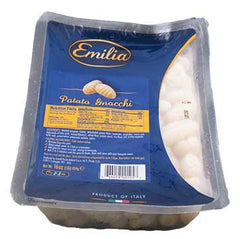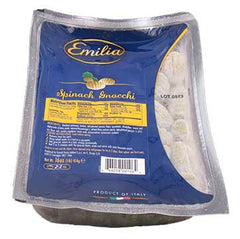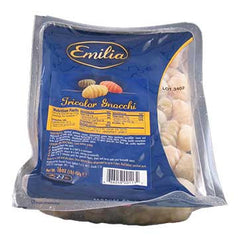RUSTICHELLA CANDELE LUNGHE, 500gr
Sold out.
CANDELE LUNGHE Pasta from Rustichella and Pierina’s Tuccu recipe
CANDELE means “candles” in Italian. This is a very long 19 inch pasta, tube shaped, like a candle. It is a typical Genovese pasta used at Christmas and also in Neapolitan cooking. Rustichella, a noted Italian pasta maker, produced these candele, but they are rarely offered in the U.S. Corti Brothers now offers them for your delectation either to be served in the classic “Christmas in Genova” style or with the sauce called “La Genovese” in Naples. The traditional Genovese style is in broth, beloved by Italians as a first course.
If you like tubular pasta like “ziti,” then candele should be on your list. To prepare them in the Genovese fashion, first make a good, rich, chicken broth. This is essential. In Genova, candele are called “Natalin” since they are used at Christmas, but can be used any time. So beginning with chicken broth, heat the broth to boiling and then add the candele to the broth and cook until tender. You need to have a fairly large pot of broth. Once the candele are cooking, take some plain Italian sausage, (I like Molinari boiling sausages) and remove the casing and make small balls, the size of large marbles, with the sausage meat. Add them to the boiling broth and pasta. You could also add some Savoy cabbage leaves, large stem removed and cut into smallish pieces. About three leaves would be enough. Add these to the broth and pasta. When the candele are tender, everything should be ready. Ladle, pasta, cabbage and sausage balls into large soup plates. Sprinkle with grated cheese. Your first course for Christmas dinner or lunch. The dish is called “Natalin in tu broddu” in Genovese.
The use of the sausage ball is very traditional, since they represent “Palanche” or coins in the Genovese dialect.
In Naples, there is a sauce called “La Genovese.” There is nothing like it in Italian cuisine, although Genovese tuccu is similar. Even the name is controversial. Some say that Genovese cooks in the port area made a sauce like what became La Genovese. But here is my theory: In the 1400s, when Naples was ruled by the Aragonese (yes, the Spaniards) one of the viceroys of Naples was a Genoese nobleman from the Adorno family, Giacomo Adorno. He would have brought his own cooks to Naples. The easiest way for a fashion to take hold is to have it used by the ruling class. But this is my theory.
The classic sauce in Genova, (U Tuccu), is a vegetable based one, with or without a piece of meat in it. It is now found wherever Genoese are found! On our website you will find a recipe for it, called Pierina’s Tuccu, my grandmother’s recipe, which was redone by my late sister Illa.
La Genovese used in Naples is merely a more complicated and richer recipe using meat and onions to create it. There are any number of recipes for it on the web. A very good one is that shown on Italia Squisita. It is with two Neapolitans: Antonio Sorrentino and a housewife cook, Carmela Abbate. It’s with English subtitles. It just takes time.
But, my grandmother’s recipe also takes time and is essentially like La Genovese, showing that there is similarity. Except, the Neapolitans had to make it richer and slightly different. It is also a recipe which doesn’t use a lot of tomatoes in it, showing that in Italy tomatoes were really not eaten until several centuries later than when first introduced. The Genoese word for tomato is still similar to its original: “Tumata” from the original xitomatl in Nahuatl. In Italian, tomato is “pomodoro,” golden apple, which gives an idea as to its color. The first recipe in an Italian cookbook, using tomatoes dates from Lo Scalco Moderno of Antonio Latini, published in Naples in 1694. There are two sauces called “salsa alla spagnola” which read just like what today’s Mexican salsa is like. But I digress...
The two recipes for Tuccu and La Genovese are similar. Tuccu can be made without meat and is delicious--or with a piece of beef or pork, which then would be used as the second course when pasta, the first course, was dressed with the sauce. La Genovese from Naples is merely lily gilding on the tuccu sauce. If meat is needed, why use just one when beef, pork, and veal could be used together. The notion in La Genovese is that an equal weight of thinly sliced yellow onion will be added to the meat, left to cook slowly and melt, forming the sauce. In the Genoese tuccu, dried porcini, re-hydrated in warm water and finely chopped, take the place of meat. However, using a piece of meat shouldn’t stop you from using dry porcini as well!
(My grandmother’s friend in San Francisco, Caterina Ferrando, a brilliant cook, once made my family a dish similar to La Genovese, using a piece of veal and instead of lots of onions, added two bunches of roughly cut celery. This was cooked covered , in the oven, and when the celery was soft, it was put though the finest face of a food mill and then served as the sauce for the cooked meat.)
So, if you want to try either recipe, Candele by Rustichella will do very nicely. In fact, you can also break them in half if you don’t like the aspect of the whole candele. But either way, here is something to keep you in the kitchen for some delicious dishes which are easy to prepare, with mindless cooking. It just takes some time, but definitely worth it.











